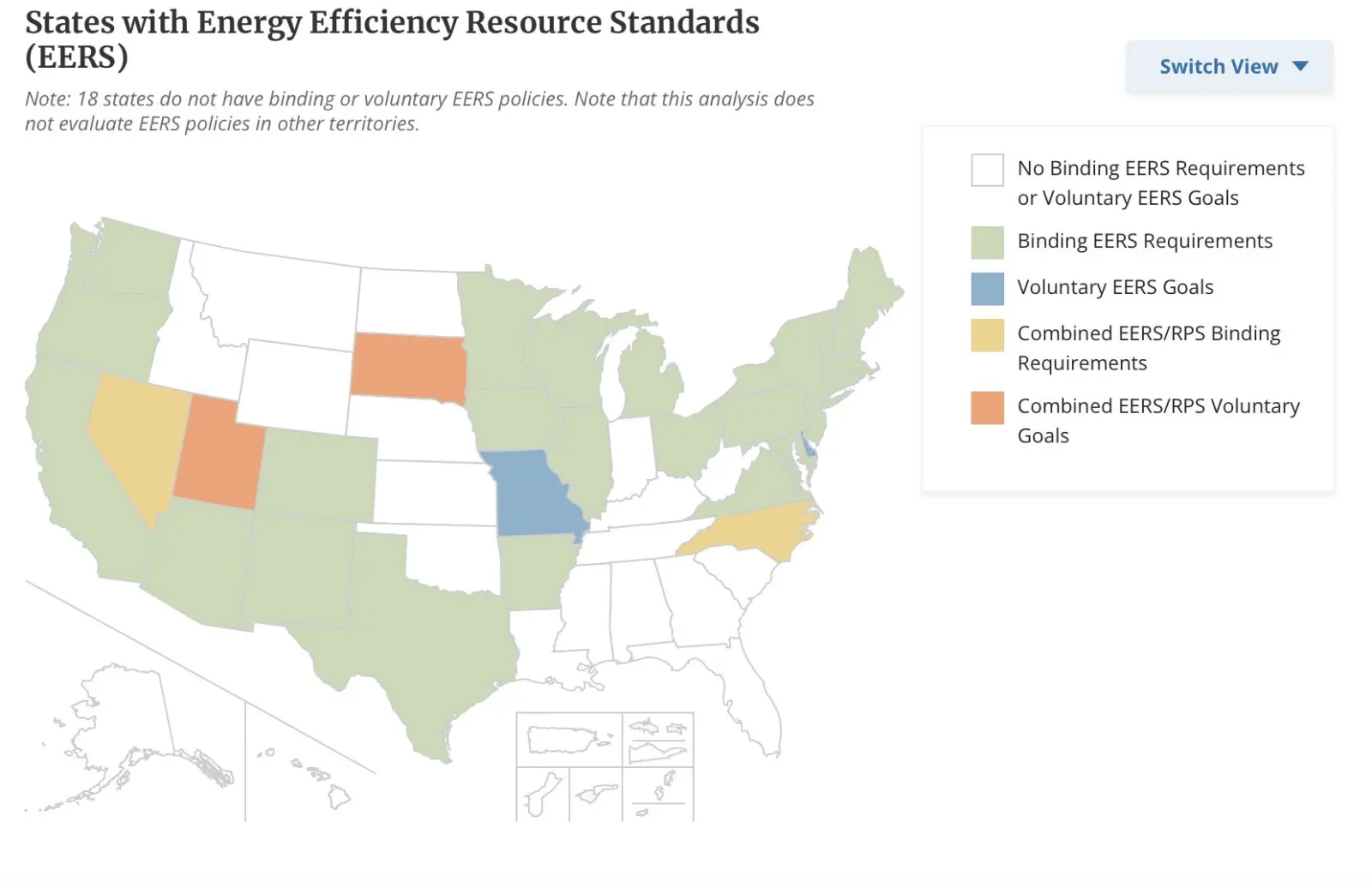Climate XChange’s Dashboard Digest is a deep dive on each of the policies that we track in the State Climate Policy Dashboard and an exploration of how these policies can interact with one another to form a robust policy landscape. The series is intended to serve as a resource to state policy actors who are seeking to increase their understanding of climate policies, learn from experts in each policy area, and view examples of states that have passed model policies.
Two investor-owned utilities in Massachusetts lead the nation in energy savings according to the 2020 Utility Energy Efficiency Scorecard from ACEEE. In 2018, the most recent year that data was available, both National Grid MA and Eversource MA achieved greater than three percent energy savings from the year before, and spent 10 percent of their total revenues on customer energy efficiency programs.
But traditional utility business models tend to disincentivize electric and gas companies from investing in anything that lowers energy sales, so what made Eversource and National Grid achieve such impressive savings? In part, it’s because they are required to do so through a state policy called an Energy Efficiency Resource Standard (EERS).
Since 2008, Massachusetts’ Green Communities Act requires the state’s electric and gas utilities to satisfy energy demand through cost-effective energy efficiency measures before more expensive resource investments, like power plants or other infrastructure.
This article for our Dashboard Digest series provides an overview of how EERSs work, what makes them effective, and why they are critical in order for states to achieve their climate goals.
What Are Energy Efficiency Resource Standards?
Of the energy that makes it to buildings, a lot ends up being wasted — commercial buildings waste an average of 30 percent due to system inefficiencies. In order to meet their climate goals, a number of states have begun to prioritize energy efficiency measures. One way that they can ensure energy savings is through Energy Efficiency Resource Standards (EERS).
EERSs are long-term targets for energy savings that must be met by utilities through customer-based energy efficiency programs. They’re similar to Renewable Portfolio Standards which require utilities to procure a certain amount of renewable energy, except that EERSs require utilities to clean the grid by reducing electricity demand altogether, instead of producing more.
Read more about how Renewable Portfolio Standares help states create demand for renewable energy.
READ MORE >
Unlike Renewable Portfolio Standards, an EERS can apply to the state’s electric utilities, natural gas utilities, or both (though the savings requirements are usually different). Energy savings targets can be established directly in the legislation, or set by a state body such as a PUC or advisory council. EERS have been adopted in 32 states, although four have voluntary targets with no penalties for utilities that fail to meet them. With an EERS, utilities must treat energy efficiency as a resource the same way they would wind, solar, gas, or any other supply-side resource.
How do Utilities Meet Energy Efficiency Resource Standards Targets?
Utilities can satisfy the requirements of a state’s EERS through a number of different energy efficiency programs. These can include demand-side measures, like incentivizing high efficiency appliances and lighting upgrades and building retrofits, to improvements in the utility’s distribution network. The state’s EERS will often describe which types of programs are eligible to meet the requirements.
Initial energy efficiency programs typically target the most cost-effective and easily accessible measures like appliance upgrades. Over time, to continue to meet annual energy savings targets utilities may shift their programs to strategies that achieve deeper energy savings through whole-building or infrastructure system retrofits.
How are Energy Efficiency Resource Standards Funded?
Improvements to energy efficiency may be cheaper than most other supply-side resources, but they can still be expensive. There are several main ways to fund the programs that utilities use to satisfy EERS requirements:
- State public benefit funds: These funds are collected through utility ratepayers, usually through a surcharge on their energy bills, and can be used for a variety of clean energy and energy efficiency programs.
- Utility cost recovery mechanisms: In the traditional business model, utilities’ revenues are directly linked to energy sales, which can disincentivize investments in efficiency. Utilities can propose methods to recover the costs of their energy efficiency programs including adjusted rate design, revenue decoupling, or performance incentives. All of these can provide new revenue opportunities to make up for lower energy demand due to efficiency programs.
- State investments from other sources: States can also pull revenue from other sources to invest in energy efficiency, such as auction revenue from a cap-and-trade program, federal funding programs, green banks, and budget appropriations. These funds can be earmarked for clean energy and energy efficiency programs and could be used to support EERS targets. Additionally, some federal opportunities, like the Home Energy Rebate Program, can be used by states and tribes to fund energy efficiency programs used to satisfy EERS requirements.
What Makes Energy Efficiency Resource Standards Effective?
EERSs vary considerably between states, but there are some components that can lead to more substantial energy savings:
- More ambitious targets: EERS targets can range anywhere from 0.5 percent annual energy savings up to 3 percent in some states. Smaller requirements don’t limit the amount of savings that utilities can achieve, but higher targets are more likely to ensure utility investment.
- Targets are long-term: Like Renewable Portfolio Standards, one of the goals of EERSs is to create a stable market for energy efficiency investment. Many states set EERS requirements for periods of several years, and then reevaluate the targets for the next period of time.
- Targets are mandatory: Unless EERS goals are mandatory, utilities may not feel compelled to achieve the energy savings that the state desires. Along with mandatory targets, there should be financial penalties for utilities that fail to meet the requirements.
- Other supportive policies: EERSs exist in a large suite of policy instruments that promote energy efficiency. Other tools including advanced metering, energy data access, and utility business model reforms may help states see greater energy savings through their EERS.
- Programs are cost-effective: It’s important that programs that utilities use to meet their EERS targets are cost-effective and provide an overall benefit for customers. For example, if programs are funded through rate increases, it’s important that the energy savings would still lower overall energy costs.
- Equity considerations: Some EERS have provisions that ensure that program benefits are distributed equitably across income levels and for disadvantaged communities.
Learn more about other Buildings & Efficiency policies on our Dashboard Resource Hub.
READ MORE >
Why are Energy Efficiency Resource Standards Important?
In order to adapt to the impacts from climate change and protect those most vulnerable, our energy systems need to evolve. Clean energy, like solar and wind, is a major part of this transition, but it can take new renewable projects years before they are approved. Making existing systems more efficient, on the other hand, not only results in immediate financial and emissions benefits, but energy efficiency measures can help future renewable projects maximize their potential.
Read more about how interconnection standards can help states fast-track renewable projects.
READ MORE >
States with EERS in place are strongly set up for success in terms of energy savings. Research from ACEEE found that in 2017, states with EERS achieved an average of four times greater energy savings on retail electricity sales than states without EERS.
EERSs, much like Renewable Portfolio Standards, help to introduce economic certainty into energy efficiency planning. When the state government sets these targets, it signals a long-term commitment to clean energy and energy efficiency which can attract investment from the private sector. The multi-year time frame can also be helpful in utility resource planning processes. Utilities are asked to treat energy efficiency as they would any other resource to meet energy demand and the targets help them plan years into the future.
What Can States Do?
To date, 32 states have adopted Energy Efficiency Resource Standards, but their strength and success varies widely. In states without an EERS, adopting them can help increase their energy savings potential, even if they already have efficiency programs in place. For states that already have EERS, those policies can always be strengthened and renewed.
Strengthening EERS could include covering additional entities in the state, like all utilities or setting requirements for gas utilities. States can also increase the savings requirements that utilities must meet each year. This happens in some states as they renew their multi-year plans, whereas in others the EERS is weakened or fails to renew. For example, Ohio enacted HB 6 in 2019 which effectively ended the state’s EERS. The EERS, originally enacted in 2008, required the state’s utilities to reduce energy use by 22 percent from 2008 levels by 2027, but HB 6 allowed utilities to end their programs once they achieved 17.5 percent instead, which most had already done at that time.
It’s also important for states to implement supporting policies and programs that incentivize utilities investment in energy efficiency. These can include cost-recovery policies like revenue decoupling, adjusted rate design, or performance incentive mechanisms that reward utilities for meeting predetermined goals while diversifying their revenue streams.
State Example
Arizona
The Arizona Corporation Commission (ACC) adopted Energy Efficiency Resource Standards in 2010 which required certain electric utilities to achieve 22 percent in cumulative energy savings by 2020, with annual energy savings targets ranging from 1.25 percent to 2.5 percent of the previous year’s retail sales, and 6 percent for gas utilities. The energy savings could primarily be met through demand-side management (DSM) programs, which provide incentives for customers to replace equipment with more efficient options, but utilities could also count savings from updated building codes, combined heat and power installations, or self-directed customer energy savings, but excluded efficiency improvements to the utility’s distribution infrastructure.
The law required each utility to submit an implementation plan to the Arizona Corporation Commission every two years detailing their compliance with the EERS, a description on how they plan to meet the next targets, the estimated cost of the programs, and how they intend to recover those costs. The implementation plan and recovery-cost methods must be approved by the ACC.
To complement the EERS, and to remove the financial disincentive for utilities to invest in energy efficiency, the ACC adopted a policy to allow utilities to propose revenue decoupling, which severs the direct link between energy sales and revenue.
Read more revenue decoupling in our article on utility reform for our Dashboard Digest.
READ MORE >
From 2010-2019, energy efficiency investments cut the state’s greenhouse gas emissions by more than 17 million metric tons, saved ratepayers more than $1.4 billion, and accrued nearly $4 in total benefits for every $1 spent.
After the EERS expired in 2020, the state has gone back and forth but ultimately has not adopted new standards. In November 2020, bipartisan members of the ACC voted to set new energy efficiency targets for utilities to meet by 2030. The rules were ultimately voted down in May 2021 after commissioners changed the clean energy mandates into less enforceable goals, even though they were actually supported by the state’s largest investor-owned utilities.
Then one last time, the ACC restarted rulemaking process for a clean energy package which included an extension to the state’s EERS, only to have it voted down once again in January 2022. More recently, the ACC directed two investor-owned utilities to expand energy savings when they approved their energy resource plans.
Currently, Arizona does not have an active EERS, although the state’s largest utilities have set their own clean energy goals for the coming decades. It should be noted that these goals are voluntary, as the state’s Renewable Portfolio Standard requires just 15 percent renewable energy by 2025.








